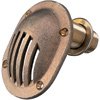For my 1995 208.
I installed a live well this past season and used a simple hose over the stern for water intake. That worked only ok, not great at speed though. I'd like to install a thru hull this Spring before the boat goes in the water. I'm a little unsure where to put it though. The live well lives up against the motor well. The hoses to the pump run through the aft bilge. Pump is mounted on the stern wall next to the oil tank.
My options as I understand it:
-a simple thru hull fitting off the stern? Seems like that will be out of the water on plane.
-PVC or brass?
-High speed strainer mounted under the hull at the stern? How hard is it to mount this sucker in the aft bilge?
Thank you in advance for any advice or tips.
Travis
I installed a live well this past season and used a simple hose over the stern for water intake. That worked only ok, not great at speed though. I'd like to install a thru hull this Spring before the boat goes in the water. I'm a little unsure where to put it though. The live well lives up against the motor well. The hoses to the pump run through the aft bilge. Pump is mounted on the stern wall next to the oil tank.
My options as I understand it:
-a simple thru hull fitting off the stern? Seems like that will be out of the water on plane.
-PVC or brass?
-High speed strainer mounted under the hull at the stern? How hard is it to mount this sucker in the aft bilge?
Thank you in advance for any advice or tips.
Travis


